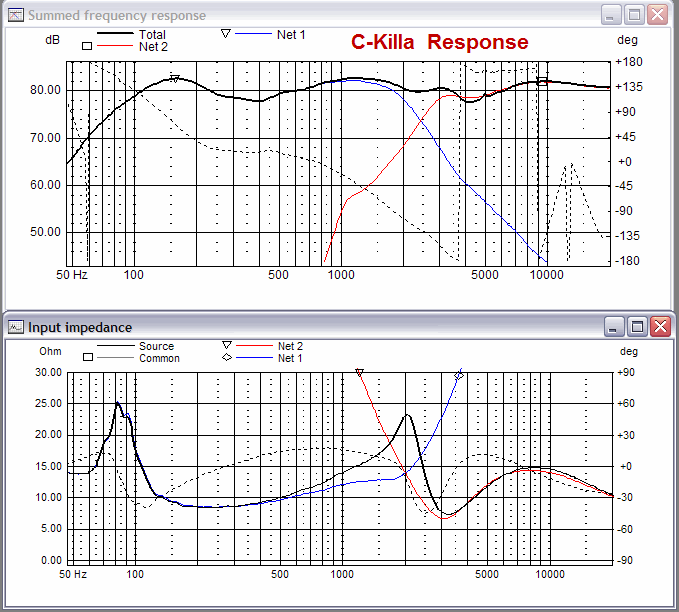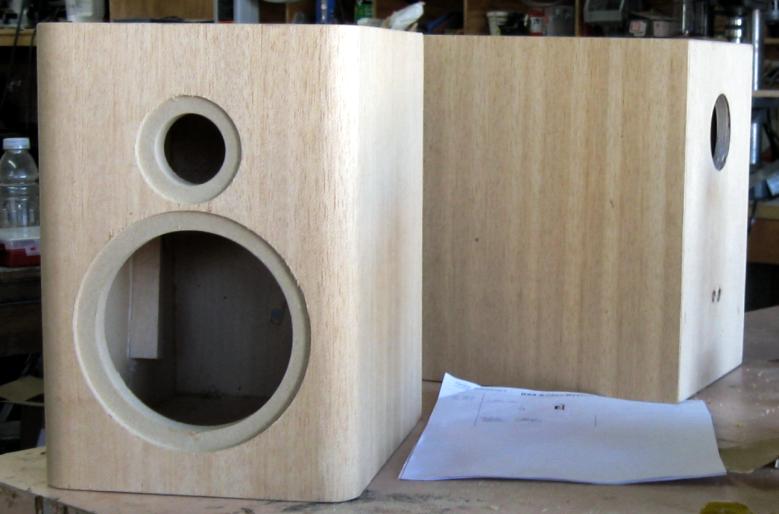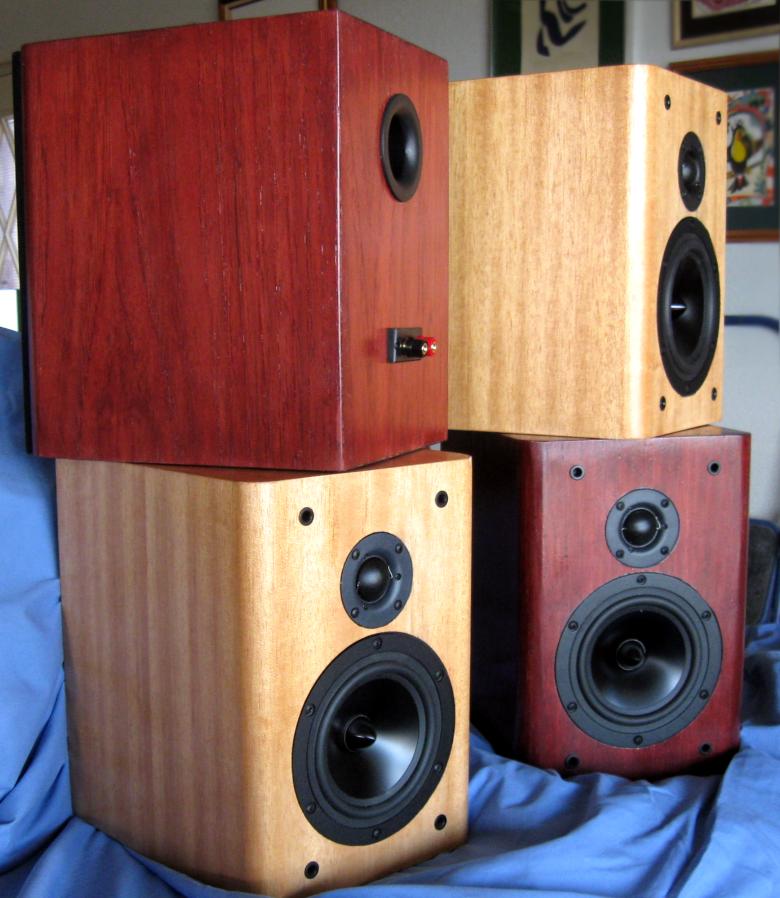
 |
Dayton ND28F-6 Tweeter |
 |
Dayton RS-150S-8 Woofer in 8.5 liters Port tuned to 53 Hz |
After an 18 month battle with a rare variant of thyroid cancer, I spent far too much time with a couple of exceptional doctors. My surgeon & oncologist. Both provided exceptional care and actually gave a damn. (The surgeon actually gave me his cell phone number!) It will be awhile before I know the final outcome of my treatments. But I do know that the two words you don't want to hear from a doctor - "That's interesting.." So with a garage full of drivers, "thank you" gifts became the C-Killas.
It's always a bit dicey guessing what people might like, how (or if ) they will use them, and the environment in which they will live. I wanted a speaker suitable for a variety of sources, locations, and tastes. I knew the RS150 was a safe bet. I had yet to try the ND28. I wanted a relatively petite box (less than 12" tall) so it would fit most bookshelves, bedroom dressers or entertainment centers. Seemed like a good match.
I'm experimenting more with box size & tuning these days. I came up with 8.5 liters for the RS-150. With the PE 260-402 port tube, this should give an F3 (and box tuning) of around 53 Hz with a 1.5 db boost at about 90 Hz. It should (and does) handle a bit more power. I've given up trying to get that last 5Hz of bass out of small drivers. I don't think it does much for listening, or durability.
My 8 year old Win98 measuring computer has spent too many summers in the garage. It took a lot of futzing to get a set of measurements I thought I could use. They look so bad I won't post them. It took a lot of heuristic manipulation and hand tuning to coax a model out of my gear (I have since replaced the rig with an Edirol UA-1EX an my old Thinkpad laptop. Thanks to Dan Neubecker for the recommendation) I'll try to get an "as built" measurement.
After the first couple of prototypes, I felt the ND28 needed a bit more sparkle. I also looked thru my extensive collection of coils and tried to come up with something relatively cheap that I could build out of parts on hand. So, I decided to use all 20 gauge coils and trade off some efficiency for reducing inventory (and thinking about all of you cheapskates out there.) The version posted below is the final "as shipped" decision.
I'd guess final sensitivity at about 81db with maybe 3db of baffle step. Crossover is about 2400 Hz. I think the ND28 could go lower, but this was the best phase compromise -- and allowed me to boost the top end of the ND28 a little. The slopes on both are roughly 4th order (acoustic) LR. Clearly an 8 ohm design so it should be happy with most SS gear.
The overall sound is very clean & balanced without being overbearing. I tried it with & without the notch filter. I think it's worth the extra $10 to leave it in. The ND28 is very twitchy with respect to padding. Xavier liked 4.7 ohm for a more forward presentation Or dead room). I preferred the 5.1 ohm for a bit more laid back (= safer) presentation.
Finishing & Listening Impressions
Spraying waterbase at 102 degrees is a challenge. I had to thin everything, and clean the crud off the the nozzle every 5 minutes. My atttempt to turn Pecan heartwood into dark Cherry with water based dyes & pigments, folowed by dye-in-shellac was a moderate success. Still haven't mastered that one. The Tigerwood pair turned out just as I hoped. I finally got one pair assembled. I lined the box with 1/2" foam, lightly stuffed with dacron. The ND-28 is sweet to mount. It fits snugly into 1 3/4" hole with a 3/8" rabbet. The ports had to be creatively glued in with hotmelt as the latest batch seems a bit smaller than earlier versions.
I moved the first pair into the house and ran them off my Panasonic XR55 & Oppo (all digital). In a large, bright room (with bright source gear) the imaging, balance and presentation are all very balanced and smooth. A bit of BBC dip makes them tolerable for poorly mastered rock. Nice high end sparkle - even with the 5.1 padding. I don't think the ND28 is quite as detailed as the D25 I used in the Ruby design, but I would use it again. Not too many small faceplate tweeters can go this low. Very "sweet" sounding, could easily be mistaken for a Morel. (It sure looks like a morel from the front.)
Out away from the wall, the bass felt a bit thin (+3db boost at the receiver brought them back) Back near the wall, "flat" bass seemed right. I never got to really push them (SWMBO issues) but I really like the way they hold together at lower background listening levels. In my office, on the bookshelf, the bass is almost overwhelming. Maybe a bit bright for true nearfield work, but very good off axis. The small box/higher tuning does it's job fairly convincingly. The ultimate bottom end isn't going to overwhelm you, but the bass that is there, is very nicely controlled. At higher volumes, the bass seems relatively "bigger".
As HT mains in my large, very dead, great room, they needed a bit of treble boost running off my Yamaha receiver. Running these on "small" really let's the midrange shine. Certainly suitable for L/R/C HT applications. Nice off axis imaging.
If all speaker designs are a compromise, then the C-Killa is truly a "duct tape" design. Great for just about anything, but not the "perfect" design for any one application. They don't draw attention to themselves. I spent my time listening to the music -- not the boxes. No fatigue, no turning them down. They could easily work as apartment stereo mains, a bedroom system, HT mains or in the dorm room. All of the drivers, crossover & cabinet hardware would be less than $200/pair at regular PE retai prices (June 2009)
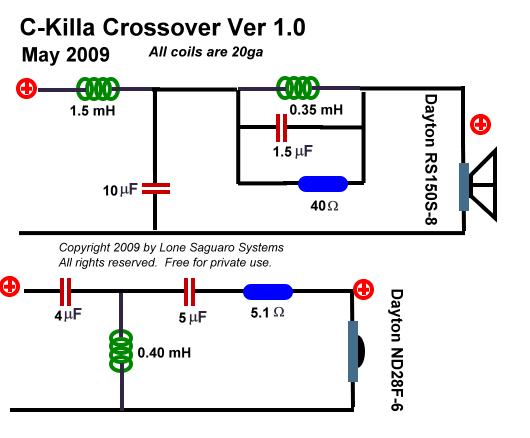 |
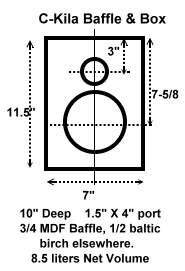 |
